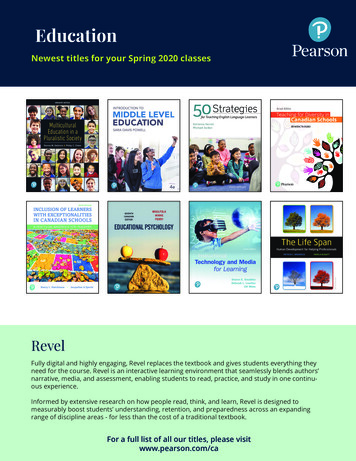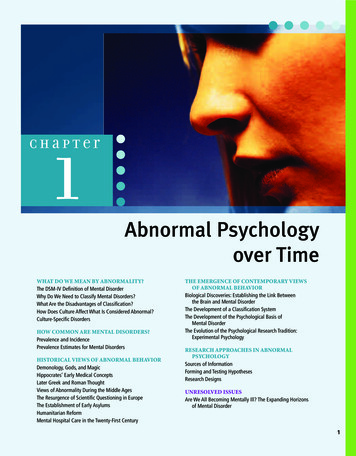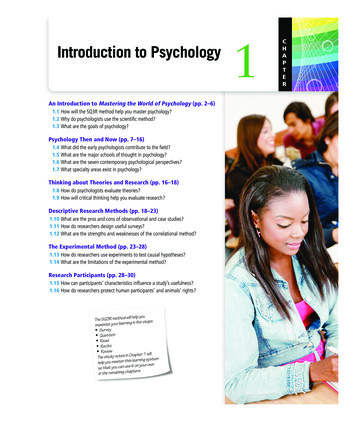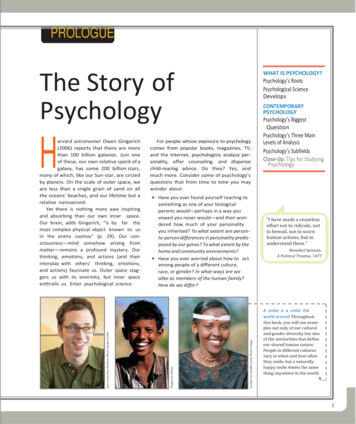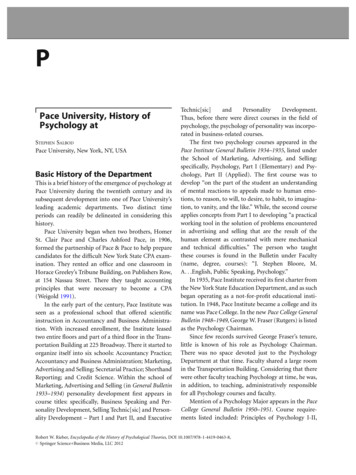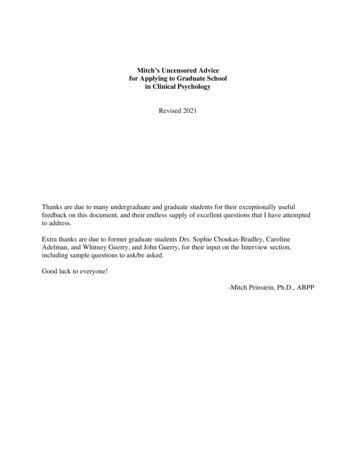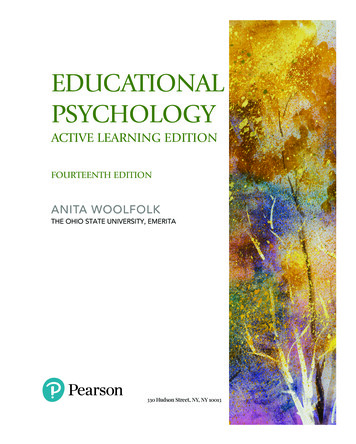
Transcription
EDUCATIONALPSYCHOLOGYACTIVE LEARNING EDITIONFOURTEENTH EDITIONANITA WOOLFOLKTHE OHIO STATE UNIVERSITY, EMERITA330 Hudson Street, NY, NY 10013A01 WOOL6508 14 SE FM.indd 106/07/2018 17:00
Director and Publisher: Kevin M. DavisContent Producer: Janelle RogersDevelopment Editor: Alicia ReillyDigital Studio Producer: Lauren CarlsonDigital Producer: Daniel DwyerEditorial Assistant: Casey CoriellExecutive Field Marketing Manager:Krista ClarkExecutive Product Marketing Manager:Christopher BarryProcurement Specialist: Carol MelvilleFull-Service Project Management: Kathy SmithCover Designer: Carie KellerCover Art: Anita Woolfolk HoyComposition: SPI GlobalPrinter/Binder: LSC Communications/WiillardCover Printer: Phoenix Color/HagerstownText Font: ITC Garamond Std. RegularCredits and acknowledgments for material borrowed from other sources and reproduced, withpermission, in this textbook appear on the appropriate page within the text.Every effort has been made to provide accurate and current Internet information in this book.However, the Internet and information posted on it are constantly changing, so it is inevitable thatsome of the Internet addresses listed in this textbook will change.Copyright 2020, 2017, 2014, 2011 by Pearson Education, Inc. or its affiliates. All RightsReserved. Printed in the United States of America. This publication is protected by Copyright,and permission should be obtained from the publisher prior to any prohibited reproduction,storage in a retrieval system, or transmission in any form or by any means, electronic, mechanical,photocopying, recording, or otherwise. To obtain permission to use material from this work, pleasevisit ents of third-party content appear on the page within the text, which constitutes anextension of this copyright page.Unless otherwise indicated herein, any third-party trademarks that may appear in this work are theproperty of their respective owners and any references to third-party trademarks, logos or othertrademarks are for demonstrative or descriptive purposes only. Such references are not intendedto imply any sponsorship, endorsement, authorization, or promotion of Pearson’s products by theowners of such marks, or any relationship between the owner and Pearson Education, Inc. or itsaffiliates, authors, licensees or distributors.Cataloging-in-Publication Data is on file at the Library of CongressISBN 10: 0-13-520650-2ISBN 13: 978-0-13-520650-8A01 WOOL6508 14 SE FM.indd 206/07/2018 17:00
To my husband,Wayne K. HoyA remarkable scholar,A demanding and caring mentor,A dedicated father and grandfather,And a wonderful companion in life.The best is yet to be A01 WOOL6508 14 SE FM.indd 306/07/2018 17:00
ABOUT THE AUTHORSo you will know your author a bit better, here is some information.Anita Woolfolk Hoy was born in Fort Worth, Texas, where her mother taught childdevelopment at TCU and her father was an early worker in the computer industry. She isa Texas Longhorn—all her degrees are from the University of Texas, Austin, the last onea PhD. After graduating, she was a psychologist working with children in elementaryand secondary schools in 15 counties of central Texas. She began her career in highereducation as a professor of educational psychology at Rutgers University, and thenmoved to The Ohio State University in 1994. Today she is Professor Emerita at OhioState. Anita’s research focuses on motivation and cognition, specifically, students’ andteachers’ sense of efficacy and teachers’ beliefs about education. For many years she wasthe editor of Theory Into Practice, a journal that brings the best ideas from research topracticing educators. With students and colleagues, she has published over 150 books,book chapters, and research articles. Anita has served as Vice-President for Division K(Teaching & Teacher Education) of the American Educational Research Associationand President of Division 15 (Educational Psychology) of the American PsychologicalAssociation. Before completing this fourteenth edition of Educational Psychology, shecollaborated with Nancy Perry, University of British Columbia, to write the second edition of Child Development (Pearson, 2015), a book for all those who work with and lovechildren.ivA01 WOOL6508 14 SE FM.indd 406/07/2018 17:00
PREFACEMany of you reading this book are enrolled in an educational psychology course as partof your professional preparation for teaching, counseling, speech therapy, nursing, orpsychology. The material in this text should be of interest to everyone who is concernedabout education and learning, from the nursery school volunteer to the instructor in acommunity program for adults learning English. No background in psychology or education is necessary to understand this material. It is as free of jargon and technical language as possible, and many people have worked to make this edition clear, relevant,and interesting.The text maintains the new, unique format that was created for the previous ActiveLearning Edition. If you didn’t see that text, this one is probably unlike any textbookyou have encountered. It is divided into 44 easy-to-read modules. Research in educational psychology points to several reasons why this format will help you learn. First, wehave known for years that learning is faster and more permanent if you study smallerchunks over a longer period of time instead of trying to jam more learning into yourbrain in a short period of time. Also, we know that learning is deeper and more meaningful if you act on what you read—connect and apply your understandings before youget too far away from the new information. Third, we know that motivation is higherwhen goals are specific, the task is moderately challenging, and it can be accomplishedwith reasonable time and effort. Fourth, more frequent testing and checking your understanding early lets you correct misconceptions and relearn so you do not remember thewrong information. Finally, we know that your lives are full and your assignments aremany, so shorter, more manageable readings fit better into your schedule. Masteringthese active learning modules will help you become more self-regulating and in chargeof your own academic life. So welcome to a better, more research-based way to learneducational psychology—my favorite subject!Since the first edition of Educational Psychology appeared, there have been manyexciting developments in the field. The fourteenth edition continues to emphasize theeducational implications and applications of research on child development, cognitivescience, learning, motivation, teaching, and assessment. Theory and practice are notseparated in the text, but are considered together. The book is written to show howinformation and ideas drawn from research in educational psychology can be applied tosolve the everyday problems of teaching. To help you explore the connections betweenresearch and practice, you will find in these pages a wealth of examples, lesson segments, case studies, guidelines, and even practical tips from experienced teachers. Asyou read this book, I believe you will see the immense value and usefulness of educational psychology. The field offers unique and crucial knowledge to any who dare toteach and to all who love to learn.NEW CONTENT IN THE FOURTEENTH EDITIONAcross the book, there is increased coverage of a number of important topics. Some ofthese include: Increased coverage of the brain, neuroscience, and teaching emphasized inCluster 2 and also integrated into several other Clusters. Increased coverage of the impact of technology and virtual learning environments on the lives of students and teachers today. Increased emphasis on diversity in today’s classrooms (see especially Clusters 1to 6). Portraits of students in educational settings make diversity real and humanvA01 WOOL6508 14 SE FM.indd 506/07/2018 17:00
viP REFA CEfor readers. In a number of Clusters there are new exercises asking readers to“Put Yourself in Their Place” as a way to develop empathy for many students andsituations. Increased coverage of effective application of learning principles as identified by theInstitute for Educational Sciences (https://ies.ed.gov/ncee/wwc/PracticeGuide/1)Key content changes in each Cluster include: Cluster 1: My goal is that this text will provide the knowledge and skills that willenable students to build a solid foundation for an authentic sense of teaching efficacy in every context and for every student, so there is new information on theEvery Student Succeeds Act (ESSA). Also, the section on research now includesmixed methods (complementary methods) (see Table 1.2) and evidence-basedpractice. Cluster 2: New information on the brain and brain imaging techniques, synaptic plasticity, brain development in childhood and adolescence, and implications for teaching. Also, there is greater critical analysis of Piaget’s and Vygotsky’stheories. Cluster 3: Updated section on physical changes in puberty, cultural differencesin play, childhood obesity, eating disorders and the Web sites that promotethem, parenting, aggression, racial identity, and self-concept. Cluster 4: New sections on biases in labeling, neuroscience and intelligence,problems with learning styles, ADHD, student drug use, seizure disorders andother serious health concerns, and autism spectrum disorders. Cluster 5: New information on language development, emergent literacy, language diversity, and bilingual education. Cluster 6: New coverage of intersectionality, ethnicity and race, prejudice,expanded coverage of stereotype threat, gender, gender identity, sexual orientation, and creating culturally compatible classrooms. Cluster 7: Expanded coverage of ethical issues in behavioral approaches, reasonsfor classroom disruptions, and teaching implications of behavioral learning. Cluster 8: Updated coverage of the brain and cognitive learning, multitasking,working memory and cognitive load, concept teaching, desirable difficulty,effective practice, and teaching implications of cognitive learning theories. Cluster 9: All new section on teaching for complex learning and robust knowledge, updated discussion of metacognitive strategies, retrieval practice,worked examples, argumentation, and critical thinking. Cluster 10: New sections on designing learning environments, facilitating inconstructivist classrooms, scaffolding, asking and answering deep questions,and the flipped classroom. Updated discussion of collaboration, learning in adigital world, and computational thinking. Cluster 11: Updated coverage of modeling, self-efficacy and agency, teacher efficacy, self-regulated learning, and emotional self-regulation. New section on grit. Cluster 12: Cluster reorganized around five broad themes in motivation. Updatedtreatment of expectancy-value-cost theory. New section on mindsets. Updatedmaterial on flow and on the TARGET framework for motivation. Cluster 13: New sections on the role of relationships, social skills, and mentoring in classroom management. Updated material on dealing with discipline problems, bullying and cyberbullying, restorative justice, and culturallyresponsive classroom management. Cluster 14: Updated research on teaching, homework, and teacher expectationsas well as new sections on learning targets, the Common Core, asking deepquestions, and giving feedback. Cluster 15: New sections on formative and interim assessment, guidance forusing different types of test formats and rubrics, and assessing complex thinking. Updated material on discussing test results with families, controversiesaround high-stakes testing, value-added assessment, and PARCC and SBAC tests.A01 WOOL6508 14 SE FM.indd 606/07/2018 17:00
PREFA CE42viiCLUSTE R 2 CO GN ITIVE DEVELOPMEN TA CRYSTAL CLEAR PICTURE OF THE FIELD ANDPOINT/COUNTERPOINT: Brain-Based EWHERE IT IS HEADEDPOINT .Educators are hearing more and more about brain-based educatThe fourteenth edition maintains the lucid writing style for which the book is renowned.fromthe neuroscience research on the brain?The text provides accurate, up-to-date coverage of the foundational areas withineducational psychology: learning, development, motivation, teaching, and assessment, combined with intelligent examinations of emerging trends in the field and societythatimplicationsaffectNo, theare not clear. John Bruer, the Inteof the James S. McDonnell Foundation, has lamentestudent learning, such as student diversity, inclusion of students with presidentspecial learningR 2 COGNITIVEDEVELOPMENT48 CLUSTEwritten articlesthatare criticalof the brain-basededu- blatantlyneeds, education and neuroscience, educational policy, and technology.cation craze (Bruer, 1999, 2002). He notes that many work—sNoso-called applicationsof brainresearch begin testing,withThus,activity—exploring,obserMyLab for Educationsolid science, but then move to unwarranted specula- ing. As Schanges our thinking processes. Our cogand endin a sort of appealing folk tale about the vard UnThe most visible change in the fourteenth edition (and certainly one of tion,the mostsignifitransmission, or learning from others. Wbrain and embedlearning. He suggests that for each claim, the takes plcant changes) is the expansion of the digital learning and assessment resourcesreinventknowledgeofferethateducator should ask, “Wheredoes allthethescienceend andalreadythe ingded in the etext. Designed to bring you more directly into the world of K–12 classrooms from social transmission varies accordingspeculation begin?” One claim that Bruer questions is the teach. Aand to help you see the very real impact that educational psychologyconcepts have on returnlearning,to a discussionof theinfbut nownotion of right-brain, left-braina popular ideathatfourthlearning and development, these digital learning and assessment resourceshas beenalso:around for oversection.30 years, even though neurosci- up in neence”(Pentists keepFor example,in hisandbookMaturation,activity,socialtransm Provide you with practice using educational psychology conceptsin debunkingteaching the tions.that teachers have students engage their “right brains” by of good Help you and your instructor see how well you understand the concepts presentedgenerating and using mental imagery. Even though differ- ple learin the book and the media resources.Basic Tendencies in Thinkingent brain areas are specialized for different tasks, this spe- known f Help you more deeply think about and process educational psychologyandhowtoAs alevelsresultofofanalysis,his earlyresearchin manycialization occurs at very fineandformingin biology,use it as a teacher (and as a learning tool).visual images involves manyparts of orthe“invariantbrain. Asfunctions.”we will crammintendencies,The firsee include:later in this text, imagerycan be aarranging,good learningstrat- maycombining,recombining,andgivreThe online resources in the Enhanced Etext with MyLab for Educationofferteegy but not because it enliststhe“underutilized”rightbrainent systems. The second tendency is towarin learning (Bruer, 1999). Kurt Fischer (2009), president of 2010). Video Examples. In almost all Clusters, embeddedvideos provide illustrations of educational psychology principles or concepts in action. These videoexamples most often show students and teachers working in classrooms. Sometimes they showstudents or teachers describing their thinking orexperiences.MyLab EducationVideo Example 2.1 Podcasts. In all Clusters, AnitaTalks podcasts provide direct links to relevant selections from AnitaTalks About Teaching, a series of podcasts inwhich Dr. Woolfolk discusses how the Clusters inthis text relate to the profession of teaching.Organization Ongoingprocess of arranginginformationand experiencesMyLab EducationPodcast2.1 systems orintomentalcategories. Ordered andlogical network of relations.Adaptation Adjustment tothe environment.Schemes Mental systemsor categories of perceptionand experience.A01 WOOL6508 14 SE FM.indd 7Assimilation Fitting newinformation into existingschemes.ORGANIZATION. People are born witcesses into psychological structures—sythe world. Simple structures are continuasophisticated and thus more effective. Veran object or grasp it when it comes in colooking and grasping at the same time. Atwo separate behavioral structures into aat,for, andgraspingthe object.onereachingstudy, ller,2002;P. Hbrain activity in the motor (movement)Piagetgaveaspecialnametotheseers performing the same tasks had activschemesare thebasicbuilding blockset al., 2006).Oneexplanationis that ofChorthoughtthatallowustomentallyreprabacus—a calculation tool that involveourSchemesbe verysmall antheseworld.childrenretaincana kindof , 2008). There also are culturalgeneral—fortheread,drinkingschemFor example,example,when theynativeChibrain associated with spatial informatioADAPTATION. In addition to the tendecharacters used in written Chinese areple also inherit the tendency to adapt tthese spatial areas of the brain when tinvolved in adaptation: assimilation and aproficiency can be reached through difAssimilation involves trying to underDella-Chiesa, 2008). So thanks to plasticialready know—by using our existing schity, culture, and context. We build knowleinformation to make it fit. For example, tand ideas mentally and physically.call it a “kitty.” They try to match the newAs you can imagine, educators htifying animals.research for their instruction. We turn toAccommodation occurs when we musituation. If we cannot make new data fiNeuroscience, Learning, and Teacmore appropriate structures. We adjust oTherehas beenvigorous debatebetweofadjustingthe informationto fit ourthbrain-basededucationandtheskepticalwhen they add the scheme for recognizinies ofthe brain do not really address minganimals.Counterpointfor atosliceofincreasinglythis debate. coPeople adapttheirwhenever these schemes work (assimilschemes when something new is neededrequired most of the time. Even using aa straw requires some accommodation ifthe type you are used to. If you have trie06/07/2018 17:00that you have to add a new skill to your s
viiiP REFA CEtheir own understanding; learning is a constructive process.At every level of cognitive development, students must beable to incorporate information into their own schemes. Todo this, they must act on the information in some way. Thisactive experience, even at the earliest school levels, shouldinclude both physical manipulation of objects and mentalmanipulation of ideas. As a general rule, students should Self-Checks. Throughout the Clusters you will findMyLab for Education: Self-Check quizzes. There are fourto six quizzes in each Cluster, with one at the end of eachmajor text section. They are meant to help you assesshow well you have mastered the concepts covered in thesection you just read. These self-checks are made up ofself-grading multiple-choice items that not only providefeedback on whether you answered the questionscorrectly or incorrectly, but also offer rationales for bothcorrect and incorrect answers.74 Application Exercises. Also at the end ofeach major section, you can find one ortwo application exercises that can challenge you to use Cluster content to reflecton teaching and learning in real classrooms. The questions you answer in theseexercises are usually constructed-responseitems. Once you provide your own answersto the questions, you will receive feedbackin the form of model answers written byexperts. Practice for Your Licensure Exam. EveryCluster ends with an exercise that can giveyou an opportunity to apply the Cluster’scontent while reading a case study andthen answering multiple-choice and constructed-response questions similar tothose that appear on many teacher licensure tests. By clicking on the MyLab forEducation hotlink at the end of a Connectand Extend to Licensure exercise, you cancomplete the activity online and get feedback about your answers.M02 WOOL6508 15 SE C02.indd 72MyLab Education Self-Check 2.5CLU STER 2 COG N ITIVE DEVELOPMEN T. PRACTICE USING WHAT YOU HAVE LEARNEDTo access and complete the exercises, click the link under the images below.Scheme, Assimilation, andAccommodationPiagetian Concepts in aFirst Grade LessonUsing Cultural Tools ToGuide LearningMyLab EducationMyLab EducationMyLab EducationApplication Exercise 2.1Application Exercise 2.2Application Exercise 2.3cluster. KEY TERMS twoREVIEWAccommodation (p. 48)Equilibration (p. 49)Personal development (p. 33)Physical development (p. 33)Plasticity (p. 37)Assimilation (p. 48)Formal operations (p. 53)Positron emission tomographyC.Lecturestudentson(PET)the majorMULTIPLE-CHOICEQUESTIONSAssisted learning (p. 69)Functional magnetic resonance imaging(p. 35)persuasive techniques,and have a quizPreoperationalto assess learning.Classification (p. 53)(fMRI) (p. 35)(p. 50)1. Mr. Winstel was worried about his former star student,Coactions (p. 33)Glial cells (p. 38)speech (p.D. Have students Privateform groupsto 63)research persuasiveRamon. As theseventh-gradeyear progressed,Ramon actionswasCo-constructedprocess(p. 60)Goal-directed(p. 50) techniques.Reversibility (p. 53)frequentlybeing calledinto the principal’soffice for skateCognitivedevelopment(p. 33)Hypothetico-deductivereasoning (p. 53)Reversible thinking (p. 50)4.Researchstudiesinvolvingthebrainandlearning ondanCollective monologue (p. 63)Identity (p. 52)Scaffolding (p. 69)that all but which oneSchemesof the followinggerous. Recently,Mr. Winstel(p.to39)Compensation(p. 52)Ramon’s parents contactedLateralization(p. 48) statements is true?alert him toaxialthe factthat Ramon had been . 33)Semiotic function (p. 50)A. There is no suchSensitivething asperiods“left-brain”and “right-brain”(CAT)35) some older boys in the neighborhood.Myelination Which(p. 38)(p. 34)hangout(p.withthinking.Concrete(p. 52) would typically bestNear-infraredoptical tomographySensorimotor (p. 50)of the operationsfollowing answersdescribe whatB.Theproductionofnewneuronscontinues )is happening with Ramon?Cultural tools (p. 61)Neo-Piagetian theories (p. 58)adulthood.Social development (p. 33)A. Ramon’s culture demands that boys of his age begin toDecentering (p. 51)Neurogenesis (p. 35)Socioculturaltheory(p.60)C. Using different modalities for instruction and activitiesengage in behaviors that reflect fearlessness.Development (p. 33)Neurons (p. 35)Synapses (p. 35)senses may support learning.B. Ramon’ssystem is maturing, Objectbut hispermanenceprefrontal (p. 50) that draw on differentDisequilibrium(p.limbic49)Synaptic plasticity (p. 37)D. Pruning can damageheavilyuseddevelopmentcognitive pathways.lobeEgocentric(p.has51)not yet caught up.Operations (p. 50)Zone ofproximalElectroencephalograph(EEG) in(p. deviant35)Organization48)(ZPD) (p. 64)C. Ramon is engagingbehaviorsas a cry(p.forAdaptation (p. 48)Event-related potential (ERP) (p. 35).CONNECT AND EXTEND TOLICENSUREAdolescent egocentrism (p. 55)Executive functioning (p. 58)attention from his parents.D. Ramon is undergoing a period of synaptic pruning, whichcauses adolescents to engage in risk-taking behavior.2. Miss McClintock discovered that five of the children in herclass were developmentally advanced. All of the students’language skills were exploding! Although many of the students still had trouble sharing, a few appeared to understand that by sharing, everyone could be happy. Finally,there was even one child who could solve conservationproblems. According to Piagetian theory, in what stage arethe students in Miss McClintock’s class?A. Formal operationsB. Concrete operationsC. PreoperationalD. Sensorimotor3. In introducing students to persuasive advertising methods,which of the following approaches would be most apt tolead to student retention?A. Determine what students already know about the topic,and connect new information to their prior knowledge.B. Have students initially watch several commercials andM02 WOOL6508 15 SE C02.inddtake notes.74CONSTRUCTED-RESPONSE QUESTIONSCaseWhen planning for instruction, Mr. Gething remembered thatstudents should be neither bored nor frustrated. Although thismade sense to him, he was unsure how he would compensatefor the diverse group of students he had in his second-periodlanguage arts class. Some students had difficulty with the English language, and other students planned to participate in theschool’s annual Shakespearean play. He knew that by groupingstudents of mixed ability, he could occasionally draw on the talents of his knowledgeable students to assist the less-advancedstudents. He also understood that without guidelines, studentsmight not accomplish anything.5. Explain the theory of learning Mr. Gething is initially drawingon, and identify the individual credited with it.6. What is the term for the assistance that the more knowledgeable class members may provide to the less-advancedstudents in order to help them succeed? List some strategies these students might use to assist their peers. Classroom Management Simulations. In the left-hand navigation bar of MyLabfor Education, you will be able to access interactive simulations that engage you indecision making about classroom management strategies. These interactive casesfocus on the classroom management issues teachers most frequently encounter ona daily basis. Each simulation presents a challenge scenario at the beginning andthen offers a series of choices to solve each challenge. Along the way you receivementor feedback on your choices and have the opportunity to make better choicesif necessary.M02 WOOL6508 15 SE C02.indd 73A01 WOOL6508 14 SE FM.indd 8gradually allowing the students to do more andtheir own. Teachers can assist learning by adaptingor problems to students’ current levels, demonstrator thought processes, walking students through thea complicated problem, doing part of the problemdetailed feedback and allowing revisions, or asking qthat refocus students’ attention.MyLab Education Licensure Exam 2.113/06/2018 10:057313/06/2018 10:0306/07/2018 17:00
PREFA CEix Study Modules. In the left-hand navigation bar of MyLab for Education, you will alsofind a set of Study Modules. These interactive, application-oriented modules provideopportunities to learn foundational educational psychology concepts in ways otherthan reading about them. The modules present content through screen-capture videos that include animations, worked examples, and classroom videos. Each moduleconsists of three parts. In the first part, begin with the Learn section that presentsseveral key concepts and strategies. Then work through the problems in the Applysection. These will give you practice applying the concepts and principles to actualteaching and learning scenarios. The third part of each module is a multiple-choicetest in the Assess section. This test includes higher-order questions that assess notonly what you can remember about the module’s content but also how well you canapply the concepts and strategies you’ve learned to real-life classroom situations. Video Analysis Tool. Our widely anticipated Video Analysis Tool is also availablein the left-hand navigation bar of MyLab for Education. The Video Analysis Toolhelps you build your skills in analyzing teaching. Exercises provide classroom videos and rubrics to scaffold your analysis. Timestamp and commenting tools allowyou to easily annotate the video and connect your observation to educational psychology concepts you have learned in the text.Additional Text FeaturesWith an unswerving emphasis on educational psychology’s practical relevance for teachers and students in classrooms, the text is replete with current issues and debates, examples, lesson segments, case studies, and practical ideas from experienced teachers.Point/Counterpoint sections in each Cluster present two perspectives on a controversial question related to the field; topics include debates on the kinds of researchthat should guide education (p. 21), brain-based education (pp. 42–43), the self-esteemmovement (p. 115), pills or skills for students with ADHD (p. 161), the best way to teachEnglish language learners (p. 216), should girls and boys be taught differently? (p. 259),using rewards to encourage student learning (pp. 308–309), what’s wrong with multitasking? (p. 323), teaching critical thinking and problem solving (p. 388), problem-basededucation (pp. 416–417), are “grittier” students more successful? (p. 466), the value oftrying to make learning entertaining (p. 511), zero tolerance (p. 559), the Common Corestandards (p. 584), and holding children back (p. 642).Guidelines appear throughout each Cluster, providing concrete applications of theories or principles discussed. See, for example, pages 54, 92, 97, 146, 155, 196, 211, 242,291, 324, 349, 383, 438, 440, 459, 512, 541, 553, 588, 601, 636, and 644.Guidelines: Family and Community Partnerships sections offer specific guidelines forinvolving all families in their children’s learning—especially relevant now, when demandfor parental involvement is at an all-time high and the need for cooperation betweenhome and school is critical. See, for example, pages 51, 89, 154, 213, 305, 342, 393, 528,572, 596, and 654.Teachers’ Casebook sections present students with realistic classroom scenarios at thebeginning of each Cluster and ask “What Would You Do?”—giving students the opportunity to apply all the important topics of the Cluster to these scenarios via application questions. Students may then compare their responses to those of veteran teachers appearingat the end of each Cluster. See, for example, pages 75, 185, 275, 398, and
educational psychology—my favorite subject! Since the first edition of Educational Psychology appeared, there have been many exciting developments in the field. The fourteenth edition continues to emphasize the educational implications and applications of
